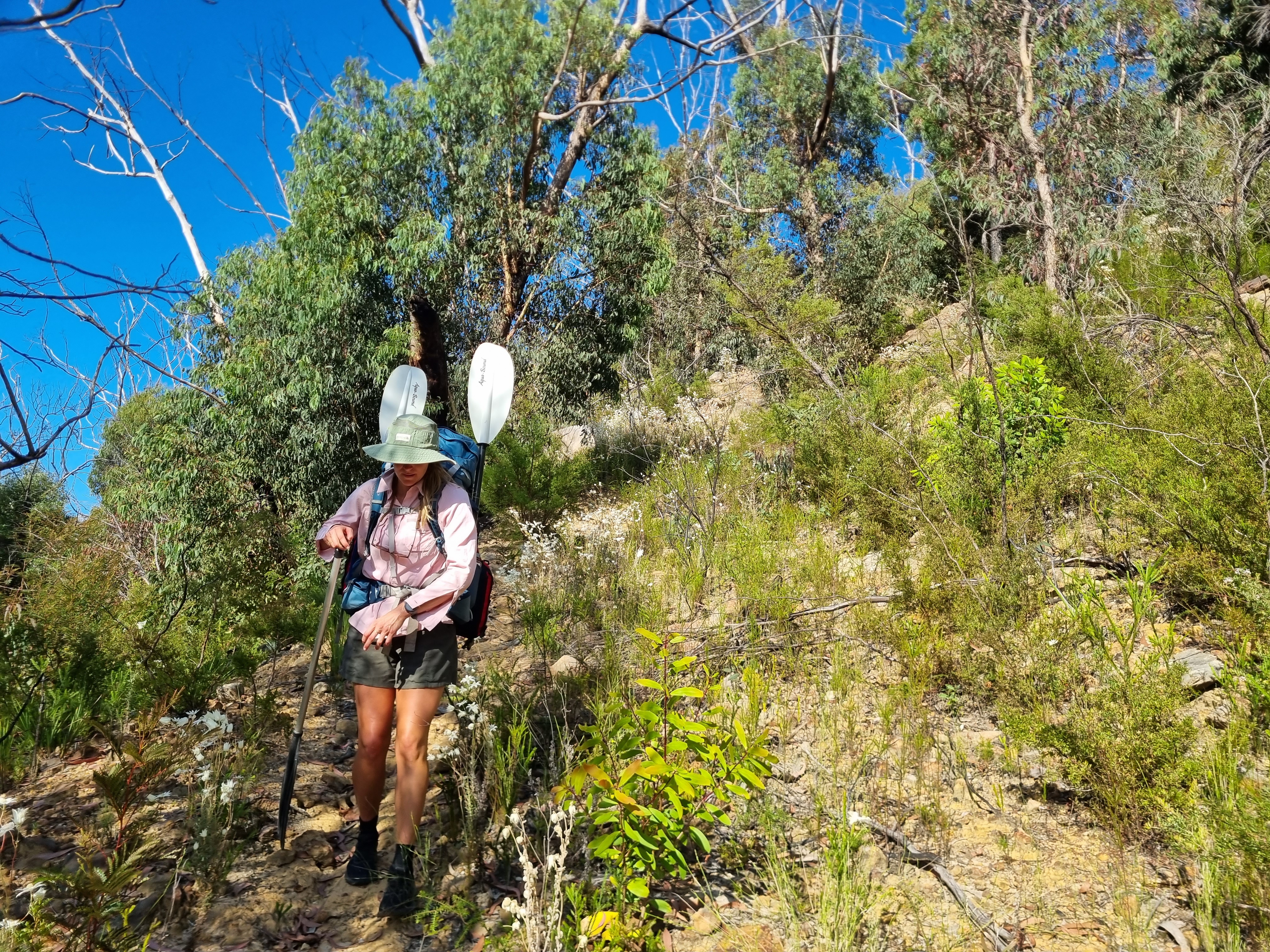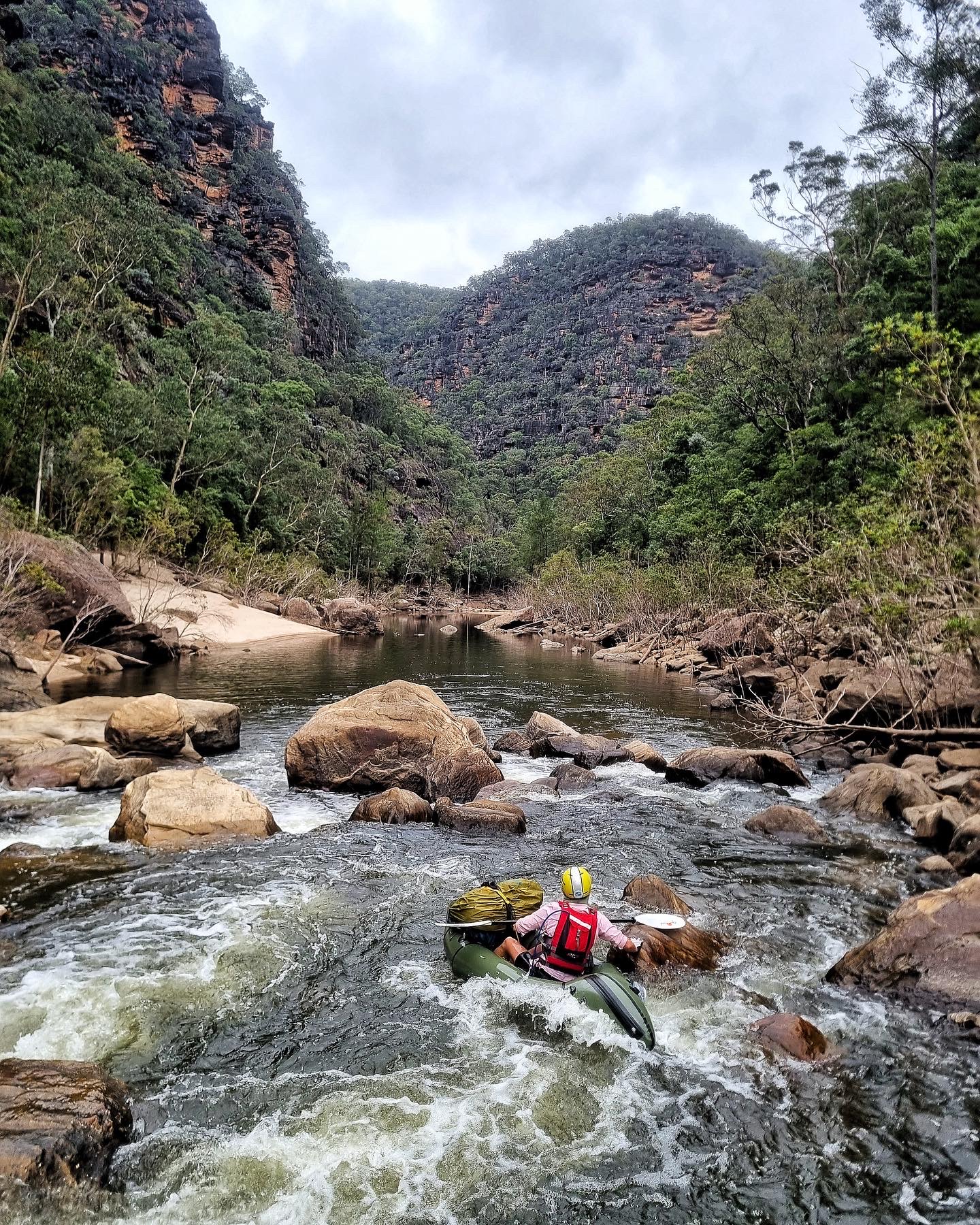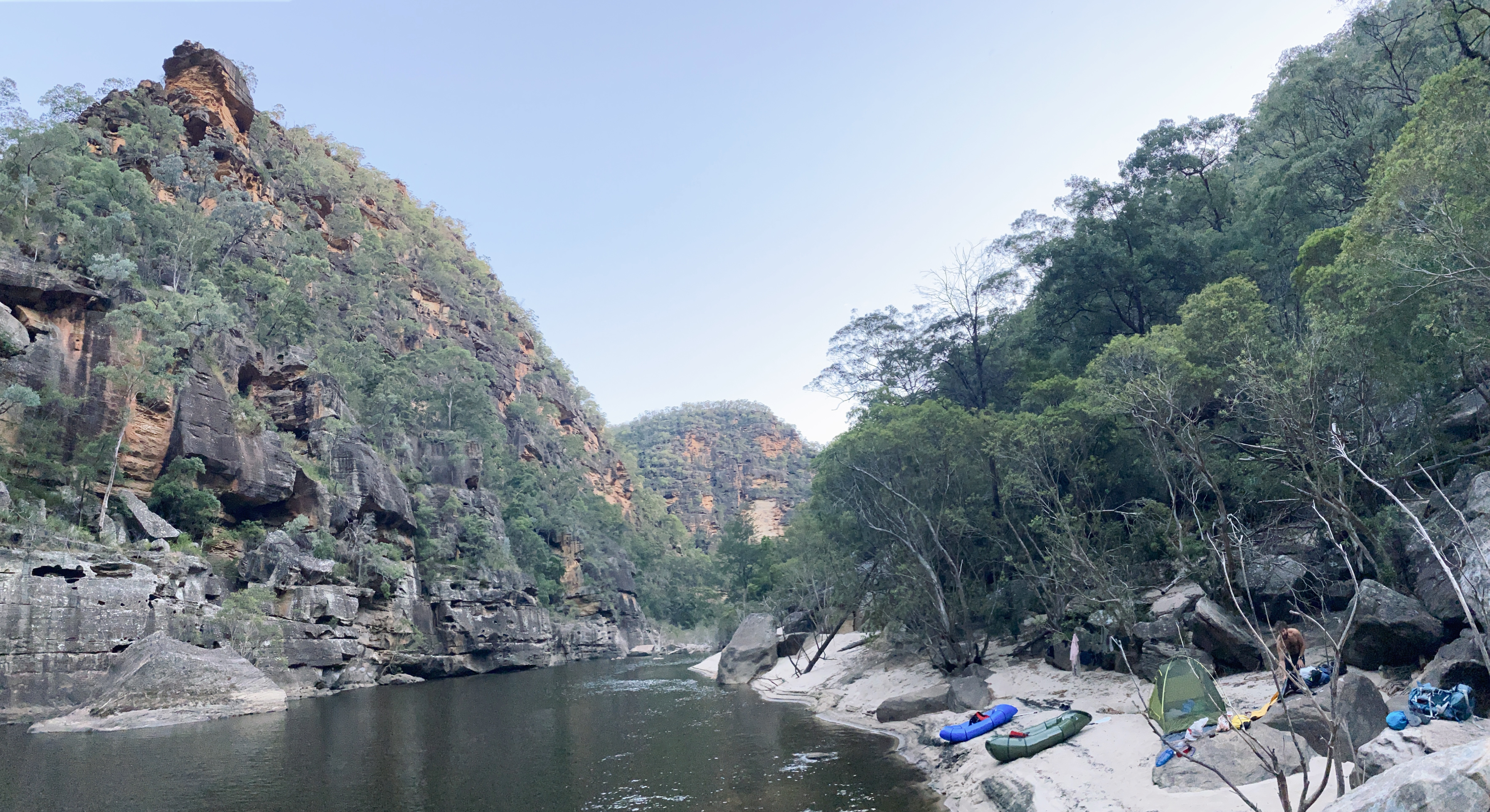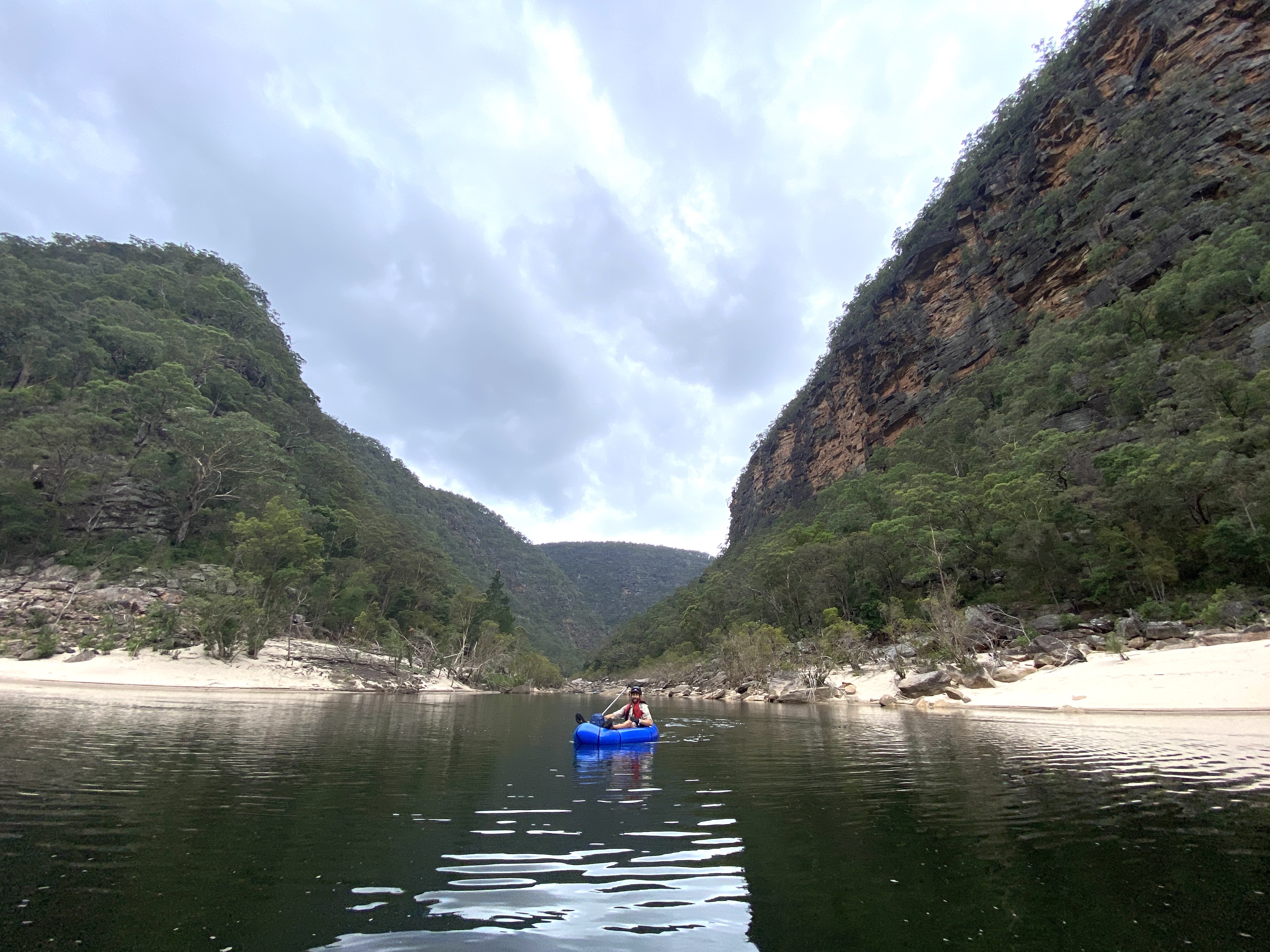This Adventure is Right In Your Backyard – Packrafting The Colo River
If paddling down twisting gullies in unspoiled wilderness is what floats your boat, then the Colo River in Wollemi National Park may be the best destination for your next packrafting adventure. The region is filled with ancient sandstone cliffs towering over 400m above the river.
The region offers trips from 1-4 nights, where you can hike into points along the river for different rapid runs with multiple camp spots along the way (river height pending). There are grade 1-3 rapids, many requiring river skills, teamwork, and white-water rafting knowledge. It’s important to note, this trip should not be attempted if your skill levels do not match the strenuous hikes in/out and whitewater rafting ability for the current river levels.
The area is complete wilderness with unknown rapids, undercurrents, and sieves with only a couple entry and exits points. Plan well before you set out as the region is more of an inaccessible landscape.
CEO of Women Want Adventure and her partner Elijah set out into the unknown to finish a year of adventure and welcome in the new.

Packrafting Down The Colo River
The end of the year goes out with an adventure – just how we like it. My partner Elijah and I set out into the deep Wollemi Wilderness to tackle the wild Colo River on a 5-day, 4-night packrafting trip.
My interest in the Colo river sparked when exploring the Wollangambe Canyon for Women Want Adventure trips. The Wollangambe, being one of the river streams feeding the Colo. I knew the region was almost inaccessible terrain, which excited my curiosity to explore further.
While I’ve spent many years sea kayaking and pushing fears, ocean waves and currents, I had not spent much time in white-water or owned a packraft. The thought of exploring a new area and testing our skills excited us both.
With grade 1-3 rapids, the Colo River would be the ideal trip to test our new packrafts. We’re both experienced hikers and kayakers, so the idea of combining rafting and hiking together was an exciting concept.

Day one we drove from Sydney to Colo River Park and dropped our car under Putty Road Bridge (our end point) for day 5. Our rafts weighed around 3kg each, and along with food, PFD’s, paddles and much needed supplies for the trip – our hiking packs weighed approximately 26kg.
It’s 31 degree’s and we’re on the side of Putty Road hitching for a lift to our start point Culoul Trail. It didn’t take long until a local called “Bob” picked us up in his rusty ute, sharing tails of the area and kindly dropping us 30km up road. “This was my favourite part of the day” Bob said as he helped lift our heavy packs from his ute. “Good luck! Be careful of the King Rapid!” Bob yelled as he pulled away.
Luck is certainly what Elijah and I needed as it turned out, in parts – the 16km hike on Culoul Trail in the heat was not easy. The worry of the heat really set in around 13km when we both ran dry of water. It had been hard enough hiking the fire trail with heavy packs, and that was before we began the last 3km steep decent through the gully to the river. We quickly realised we underestimated the terrain, which was challenging to find the route down with no path. Even with our experience, we both agreed the last section to get to the river was for the experienced.
There is the option to drive to the end of Culoul Fire Trail and walk the remaining 3km to the river (allow at least 2 hours) and definitely do not attempt at night. Sections to the water required taking off packs and lifting them one by one down the rocks, along with a rope scramble. The type of fun that starts to amplify the spirt of adventure.
“This is so good” I think as I grab the rope and abseil down the rock toward the river. Already, the bubble of the known for the unknown has me pushing through feelings of dehydration. I’m ready for this, and we’re both laughing. The possibilities of hiking into such an 'off the beaten track', beyond any guidebook is what we were here for after all.
Our first view of the river took my breathe away. Immediately, we knew we were in for a true adventure. At glace of the river levels, it matched the 0.9 by Paddle Safe Australia we expected. Low, yet manageable. We were a little worried as there had not been much rain, ideal levels would be 1.2 to 1.5, but recent consistent rainfall had bumped the Colo up to a level just enough for us to get by. In theory, this would mean more portages, rock scrambles and a few punched rafts.
At the base of the Colo our campsite awaited on the other side of the river. A densely wooded gorge that was swallowed by enormous cliffs either side of us. The sandy bank awaiting our arrival for camp on night one.
We inflated our rafts and jumped in, laughing. I look up, my face happy, eyes full of wonder. “This place is incredible” I say to Elijah as we paddle across the river. We popped up the tent, rehydrated and just had enough time to sit with a cup of miso before the light faded.
The next morning, we woke early. We had a leisurely breakfast in the sun and packed our rafts. After a short test paddle, we set off down the river with our first rapid only 300m from camp.
Reaching the rapid, you can hear the thundering roar well before the approach. Both feeling a little nervous, we navigated our way down, dodging boulders and rocks, getting washed over yet making it through with a clean line. “Woo, we did it!” I yell. Having overcome the scariness of the unknown, we looked at each other and nodded “this will be an adventure!!!”.
From the first rapid success, we were swept along at walking pace until 500m later our next rapid emerged.
Each rapid was different, and the approach varied with levels of caution. We often jumped out of the rafts to scout the best possible lines and hazards, as each rapid had its own personality and complexity. Our planned lines didn’t always go to plan. We were often turned on our side, water filled our rafts and emptying at the base of each rapid was a common occurrence. Eventually, we found our rhythm, enjoying the flat sections as they came and the rapids which felt like a nature amusement park.
From our first rapid, we manoeuvred between 10-15 rapids before breaking for lunch on a short cascade through a rocky construction. In hindsight, the rapids were relatively tame due to lower river levels, but even the tame rapids we had challenges of drops, boulders, and sections of easy flip outs. We made careful decisions to porter sections we did not feel were safe or possible to send through. Often when the water level is too low, you can run the risk of getting jammed between rocks.
The remainder of the day was filed with more rapids, our strategy for negotiating rapids changed as we developed safest ways to communicate and pass through with little concern. We were glad we were wearing helmets, good river shoes, paddle gloves and had throw lines, just in case one of us become stuck or needed rescue. Rope was often used to lead the rafts down sections not high enough to paddle to avoid puncturing the rafts.
On this day, we passed Canoe Creek, around 12km down river. A popular entry/exit point where rafters/hikers meet the river and camp. It’s a stunning location with a large open area. We decided to push past Canoe Creek and find camp further downstream on a little sandy oasis.
The sun sank behind the canyon for night two. We were defiantly overtired having paddled around 15km. We soon realised campsites had to have trees and rocks. Tonight’s camp lacked both and it was difficult to dry gear or hang items without getting sand everywhere. We made do, lighting a fire to lift our spirits. Watching the flames dance on the river refection as we drifted off to sleep.
Day three dawned with light patches of rain. To this point we had no punchers and were feeling more confident and engulfed by the beauty and rawness of the Colo. We got going around 9am with another big day ahead. We made good time with a couple of portages along the way, and a lunch stop.
The landscape was still towering gorge either side, with a few spotted eagles high. Accustomed to our packrafts, today was extremely enjoyable. Just how we envisioned to finish the year, out on the water in the wild. After a clean line rapid, we pulled up to a campsite, stunning beyond belief. Our New Years Eve couldn’t have got any better. Lots of tree’s, rocks, and a flat beach to camp on. Today was a blast and we called it around 5pm to set up camp to enjoy New Year’s watching the sun fall beyond the high canyon walls. We had covered 10km today.
We couldn’t have thought of a better place to start a new year. Enjoying breakfast on the sunny rock, we packed up camp and set off for day three. Today’s plan was to head for Bob’s Turners Camp, another popular entry/exit point. Today was set for another large paddle with the King Rapid on the horizon, a rapid we heard Bob mention as a dangerous section.
Just after lunch, we could hear the King Rapid before it came into sight. After we finished digesting the difficulty of the King Rapid, we began to prepare for portage and happy to stretch our legs across boulders. Lucky, we did. The further investigation of the King Rapid, it was clear why it was a mandatory portage. There were 4 major drops with only one narrow passage requiring difficult moves with no room for error. At the base was a large sieve and any mistake would have been disastrous. We portaged our rafts to the base of the Kind Rapid, then hopped back on the water.
We pressed on through a series of smaller rapids, and by now began noticing a change in the landscape which opened up slightly and more volume of water. Feeder creeks from the Wollangambe and Tamo Creek were adding volume to the river and we could feel it.
Getting to the end of the day, we passed Bob Turner’s campsite, another popular hike in/out location, and a beautiful one. We still had much ground/river to cover and paddled another 4km down river past the last rapid of the Colo and set up camp for night four.
Our final day threated to be yet another scorcher like our first hike in, so we were up early and left camp by 8am to paddle toward Upper Colo Heights (a decent 20km paddle). Along the length of this stretch were shallow patches of water, where we sometimes had to get out of the rafts and push along the sand. An extra 10cm of water would have been ideal!
We both quickly realised food was at shortage for this huge day, and by the time we reached Upper Colo Heights mid-afternoon with a couple of mnm’s left, we decided to deflate the rafts where the river finally met a dirt farm road. Our first sign of people! We hitched a ride with a lovely lady 10km back to our cars. How thankful we were as it would have taken another 4 hours of paddling.
On a fine summer’s day, for the end of one year and the start of a new, when all you really want to do is raft down the most beautiful gorge, lay on your back and then camp by the river, or when you want to listen to the rapids as you fall asleep with a universe of stars above, the Colo River is the place to be.
The Colo has left an incredible mark on us both, and we will be looking forward to our next visit.
Essential Gear For Packrafting
- Pack Rafts from Packraft Australia
- Towe Rope
- Helmets
- Paddles PFD’s
- River shoes
- Paddle gloves
- PLB
- Wilderness First Aid Kit
- Knife
- Repair kits
- Whistle
- Tent
- Hiking pack
- Tarp
- Ground mat
- Dry bags
- Inner pack liners
- Pack clips
- Quick dry towel
- No loose items!
- + our food, lots of chocolate, sleeping mats and bags etc
Remember that all the gear does not turn you into a professional. Packrafters must also train and practice the skills to be safe and proficient in running water and rapids.
When To Raft The Colo River
The warmer months of late spring, summer and early autumn are best. It’s essential to keep an eye on the water levels. Levels below 0.9 would not be suitable. Check the Paddle Safe App for further details. Winter would be freezing. If you own a dry suit, perhaps this would be a possibility (water level pending).
Before You Go
Your speed of travel largely depends on water levels, your rafting and hiking ability. A visit during or after heavy rains is definitely not recommended or in flooding waters.
How Hard Is Packrafting?
We love adventure. It’s why we go to wild places to explore the unknown, to challenge ourselves, plunge into rivers, sweat, laugh and cry. In doing so, we risk getting injured, lost or end up with a serious sock tan. This trip is a wilderness trip with serious high risk, which can be both inspiring and terrifying. This article is to help inform readers of the possibilities to explore our Australian backyard. To help us push physically and mentally. Risk can be positive. This is not a commercial tour operated by Women Want Adventure. Our CEO Monique and her partner are trained outdoor guides who open a map, point and get off the beaten track. Know your limits.
Make no mistake. From grade 1-5 rapids, packrafing can be dangerous. With remote locations, steep gullies and undercurrents of water, you will be in the unknown for this trip. Stay safe. Make responsibility decisions and of course, have a blast.













